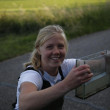Zoeken
Filteren op
Type
Labels
Dossiers
Thema's
Afdelingen
Taal
Active filters
1744 zoekresultaten
Zoekresultaten
-
Student projects: methane-cycling microbes in Greenlandic lakes (vacature in het Engels)
We are looking for a motivated BSc/MSc student who is interested in working with lake water samples and associated methanotrophs at the department of Microbial Ecology at NIOO-KNAW, Wageningen, The Netherlands. -
Renske Verkuijlen
Bio-informatician -
Pieter Jense
Concierge
-
Jiayi Jing
PhD Candidate -
MicroSOS
MicroSOS aims to establish a collaborative platform bridging academic and non-academic sectors in agriculture and facilitating knowledge exchange between researchers and industry professionals. The project focuses on enhancing agricultural resilience to climate change through microbiome-based approaches. This project is part of Staff Exchanges funded by the European Union’s Horizon Europe programme under the Marie Skłodowska-Curie Actions.
-
Camille Delavaux
Senior Researcher
-
IT administrator (vacancy in Dutch)
Ben jij een servicegerichte systeembeheerder met een passie voor innovatie die ook een gebruiker kan ondersteunen? Wil jij werken in een inspirerende wetenschappelijke omgeving waar je bijdraagt aan baanbrekend ecologisch onderzoek? Dan zijn wij op zoek naar jou! -
ICT Beheerder
Ben jij een servicegerichte systeembeheerder met een passie voor innovatie die ook een gebruiker kan ondersteunen? Wil jij werken in een inspirerende wetenschappelijke omgeving waar je bijdraagt aan baanbrekend ecologisch onderzoek? Dan zijn wij op zoek naar jou! -
Nina van Boxem
Research assistant
-
PhD Seasonal Timing of Egg Overwintering Insects under Climate Change
Climate change is exerting strong selection on wild populations, with many species showing shifts in the seasonal timing of development. One particularly vulnerable group are insect species that overwinter as eggs, with warmer winters leading to stronger population declines compared to other insect species. To predict whether insect populations can adapt to climate change, we need to know the amount of genetic variation in egg development time.
